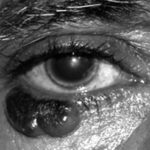About Eyelid Skin Cancer:
Eyelid skin cancer is most common on the lower eyelid, but can also form on the upper eyelid, corners of the eye, eyebrow skin, etc.
Risk Factors:
- Old age
- Fair skin
- Too much exposure to sunlight
Wearing sunscreen lotion can reduce your risk of skin cancer.
Key Points to Remember:
- The earlier the cancer is treated, the better the outcome
- Your new eyelid will look like the old one
- Regular follow-ups are very important


